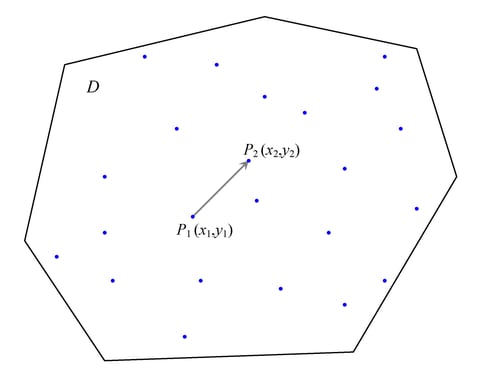The VARIOGRAM Procedure
Pair Formation
The basic starting point in computing the empirical semivariance is the enumeration of pairs of points for the spatial data. Figure 98.19 shows the spatial domain  and the set of
and the set of  measurements
measurements  ,
,  , that have been sampled at the indicated locations in
, that have been sampled at the indicated locations in  . Two data points
. Two data points  and
and  , with coordinates
, with coordinates  and
and  , respectively, are selected for illustration.
, respectively, are selected for illustration.
A vector, or directed line segment, is drawn between these points. If the length
 |
of this vector is smaller than the specified DEPSILON= value, then the pair is excluded from the continuity measure calculations because the two points  and
and  are considered to be at zero distance apart (or collocated). Spatial collocation might appear due to different scales in sampling, observations made at the same spatial location at different time instances, and errors in the data sets. PROC VARIOGRAM excludes such pairs from the pairwise distance and semivariance computations because they can cause numeric problems in spatial analysis.
are considered to be at zero distance apart (or collocated). Spatial collocation might appear due to different scales in sampling, observations made at the same spatial location at different time instances, and errors in the data sets. PROC VARIOGRAM excludes such pairs from the pairwise distance and semivariance computations because they can cause numeric problems in spatial analysis.
If this pair is not discarded on the basis of collocation, it is then classified—first by orientation of the directed line segment  , and then by its length
, and then by its length  . For example, it is unlikely for actual data that the distance
. For example, it is unlikely for actual data that the distance  between any pair of data points
between any pair of data points  and
and  located at
located at  and
and  , respectively, would exactly satisfy
, respectively, would exactly satisfy  in the preceding computation of
in the preceding computation of  . A similar argument can be made for the orientation of the segment
. A similar argument can be made for the orientation of the segment  . Consequently, the pair
. Consequently, the pair  is placed into an angle and distance class.
is placed into an angle and distance class.
The following subsections give more details about the nature of these classifications. You can also find extensive discussions about the size and the number of classes to consider for the computation of the empirical semivariogram.
 and
and  in Spatial Domain
in Spatial Domain 

